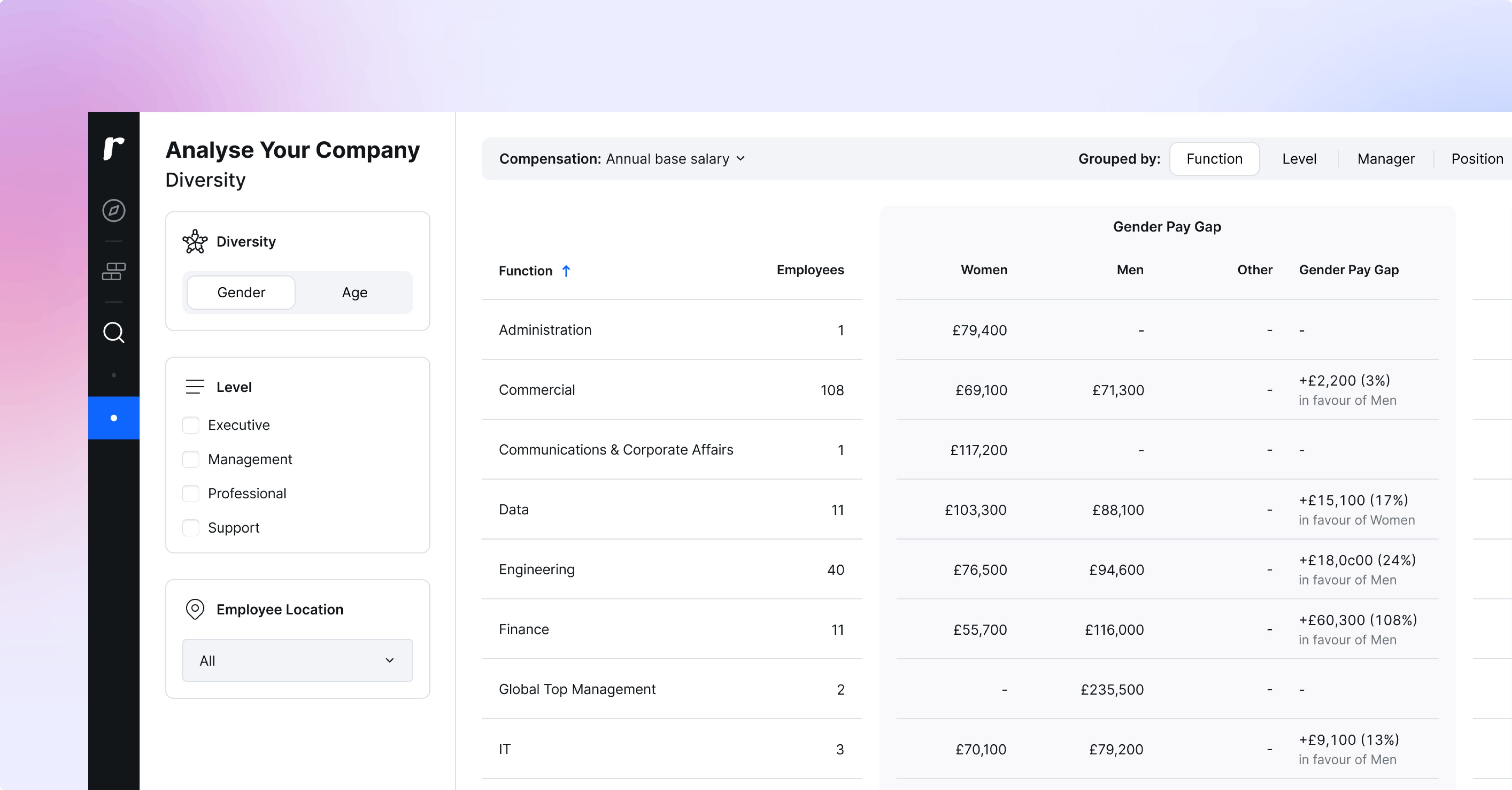Pay equity goes beyond being the right thing to do. It's soon-to-be a legal requirement for companies across the world. With the incoming EU Pay Transparency Directive and US pay transparency measures, organisations must manage their pay equity data soon, or face a risky game of high fines and potential brand damage.
But it does raise the critical question: how can companies guarantee fair compensation for all employees? And for those not monitoring pay equity, where do they even begin?
For many businesses, gathering and analysing pay equity data is daunting. The data is sensitive, and often housed in different places. You have the process of locating and centralising the data, and conducting a pay equity analysis to identify the pay gaps. It’s enough to scare even the most seasoned of compensation experts – let alone People teams in smaller organisations.
It’s unsurprising, then, why 95% of businesses are still struggling to implement effective, compliant pay equity strategies in 2024. In this post, we’ll cover what pay equity is and why it’s so important for your business, both this year and beyond.
- What is pay equity?
- Pay equity vs pay equality
- Why is pay equity good for your business?
- The benefits of pay equity software
Subscribe to our newsletter for a monthly treasure trove of insights from Ravio's compensation dataset and network of Rewards experts, to help you navigate a career in compensation 📩
What is pay equity?
Pay equity is a concept that ensures all individuals are fairly compensated for their work, irrespective of gender, age, race, or disability. Pay equity aims to eliminate any type of discrimination in compensation practices. It guarantees that everyone receives equal pay for similar work or work of equal value.
Typically, companies monitor pay equity through pay equity software – normally as part of a compensation management tool – or an Excel spreadsheet. Implementing this requires a well-defined levelling framework and a clear salary band structure. While spreadsheets are commonly used in many companies, they demand a huge amount of time, effort, and expertise to maintain, and are also prone to errors.
On the other hand, pay equity software provides an instant overview of pay equity metrics. With compensation management software, it’s easy to conduct a pay equity analysis or pay equity audit, or easily benchmark a company against market data.

Pay equity vs. pay equality: What's the difference?
Pay equity ensures that employees who perform the same or similar work are compensated equally. It follows the principle: "equal pay for work of equal value", which is central to pay equity legislation. And while differences in pay might exist due to factors like performance, location, or tenure – pay equity mandates that organisations cannot base these differences on gender, race, religion, sexual orientation, or any other demographic characteristic.
💡A quick note on unadjusted and adjusted gender pay gaps
When we look at the pay gap within an organisation, we can do that in one of two ways.
- The unadjusted gender pay gap is a term that refers to the raw difference between the median earnings between men and women. It does not account for any factors such as job level, race, age, country, or function. Instead, it provides a straightforward comparison but may not reflect important differences in job roles or other relevant factors.
- The adjusted pay gap is a way of controlling the raw data to account for external factors such as job level and country. The aim is to understand whether people are receiving equal pay for equal work. Because there are so many factors which impact pay discrimination towards women, the adjusted gender pay gap can be a more valuable metric to help companies identify where pay discrepancies are coming from.
For more information on adjusted and unadjusted gender pay gaps, check out our blog here ➡️
In contrast, pay equality addresses the broader issue of whether men and women earn the same on average across an organisation. It looks beyond a job-to-job comparison. Instead, it aims for the average salaries (mean or median) of all female and male employees to be equal, irrespective of their roles within the company.
Let’s look at an example:
Imagine a technology company where both John and Sarah are software engineering managers with similar levels of experience and responsibility.
Pay equity is achieved if John and Sarah receive the same salary for their similar roles, reflecting equal pay for equal work regardless of their gender, age, race, or other characteristics.
Pay equality, on the other hand, focuses on the average earnings of all female employees being equal to the average earnings of all male employees across the entire company. It addresses the overall balance of earnings between genders within the entire organisation, highlighting the systemic issues that influence these outcomes.
What does the unadjusted Ravio data tell us?
If John and Sarah are both managers in the UK, Sarah would earn 17% less than John. This disparity varies across different job levels within the same company:
- At the Support level, the gender pay gap is non-existent, with women earning the same as men. Women are also better represented at this level, comprising of 53% of the workforce.
- At the Professional level, the gap widens considerably, with women earning 25% less than their male counterparts and representing 39% of the professionals.
- At the Manager level, where John and Sarah are positioned, women like Sarah face a 17% pay gap and make up 36% of their tier.
- Interestingly, at the Executive level, there is no gender pay gap. Both genders earn the same, but women represent only 22% of executive roles, indicating a significant underrepresentation at the highest levels of the organisation.

Why is pay equity good for business?
Understanding the importance of fair compensation for employees is crucial. However, implementing it can be more complex. For instance, determining what is a fair and equitable salary can be challenging due to the vast amount of available data.
Next, we'll outline four key reasons why pay equity benefits your business.
1. Compliance with pay equity legislation
One of the main reasons pay equity is so important for business is to ensure companies comply with any legislation around it. As we’ve mentioned, the biggest change on the horizon is the incoming EU Pay Transparency Directive. This huge piece of legislation will come into effect across EU countries, including France, Germany, and more by 2026. The aim? To remove discrimination and ensure equal pay across men and women.
It affects all EU businesses and companies with more than 100 employees based in EU member states. And despite it coming into full force in less than two years, Ravio’s Compensation Report shows that nearly half (45%) of organisations believe the implementation of the legislation is still too far away to be a priority.
It’s crucial that companies get on the front foot when it comes to pay equity data. Doing so too late may come at a high cost for your business.
“Pay transparency allows workers to detect and prove possible discrimination based on sex. It also shines light on gender bias in pay systems and job grading that do not value the work of women and men equally ... Since such bias is often unconscious, pay transparency can help raise awareness of the issue among employers and help them identify discriminatory gender-based pay differences.”
2. Better retention, less turnover
According to Gartner research, only 32% of employees believe their pay is fair. And whether or not that’s actually true can oftentimes be irrelevant. When it comes to retaining your best talent, it’s important to control perception.
The same study found that employees who perceive their pay as unequitable have a 15% lower intent to stay with their employer than those who don’t. What’s more, for those who do stay, engagement at work is down by 13%.
Ravio’s data tells a similar story. We found that the median tenure of an employee in a European tech company is 1 year and 9 months. To improve this, we found that 78% of People teams are increasing their focus on up-skilling, pay transparency, and salary reviews using benchmarking data. This is all geared towards having better pay equity in the future.
At the leadership level, our upcoming Pay Equity report highlights a significant gender disparity in executive positions. Specifically, male executives tend to stay in their roles 46% longer than their female counterparts. While pay equity is a huge, contributing factor – our new report will explore this issue in greater detail, among other findings.
3. Improved diversity and performance
Pay equity inherently fosters a diverse workforce. By ensuring fair compensation free from discrimination based on gender, race, age, disability, or other characteristics, companies create an environment conducive to a thriving diverse team. This is a significant advantage in attracting talent. For instance, the PwC ‘Women in Tech’ report reveals that 83% of survey respondents actively seek employers renowned for their commitment to diversity, equity, and inclusion.
The benefits of diversity and inclusion also extend beyond ethical considerations—they directly enhance business performance. Research by McKinsey shows that diverse companies are now more likely than ever to outperform less diverse peers on profitability. In fact, gender-diverse teams on the executive level are 25% more likely to have above-average profitability. Companies in the top quartile with ethnic- and culturally-diverse teams also outperform those in the fourth quartile by 36%. It’s clear that the higher the diversity, the higher the chance of outperformance.
4. Boosted morale and work environment
The importance of pay equity goes beyond compliance and employee retention. It significantly influences workplace morale and the culture you aim to establish as well. Employees who perceive their compensation as fair experience increased satisfaction and a stronger sense of belonging. These are both vital for boosting productivity, job satisfaction, innovation, and an enriched workplace culture.
What’s more, demonstrating a commitment to fair pay not only reflects positively on your brand but also pays dividends. A 2022 Edelman report indicates that 60% of job candidates choose employers based on alignment with their personal values and beliefs, underscoring that fair and equitable compensation is crucial in attracting and retaining the best talent.
Benefits of pay equity software
The average time it takes to conduct a comprehensive pay equity audit varies between 2 - 5 months. It’s dependent on whether you have someone in-house, or whether you rely on a third party vendor.
Whatever it is, a pay equity review is not a simple, linear process. It typically has several re-runs, where you need to find and address the complexities in your data and measure the impact of your changes.
While every company has their own requirements for pay equity software, below are some of the basics of a pay equity software product. It must be able to:
- Compare workers across cohorts such as age, gender, race, education level, and other protected identities
- Analyse compensation plans to identify gaps and potential issues for risk mitigation
- Share actionable insights and create a remediation plan to address disparities
Some benefits of managing pay equity through Ravio include:
- Gain a holistic view of your pay equity data: Access an easy-to-use dashboard that breaks down your pay equity data across job functions, levels, and countries. Gain a snapshot view of your company’s pay gaps across both gender and age, and benchmark your company against the market in seconds.
- Attract and retain the best talent out there: Always be on the frontfoot by addressing pay gaps or concerns before they become an issue, helping you to attract and retain the best talent out there.
- Communicate the importance of pay equity to your leadership: Use the dashboard to showcase where your organisation sits when it comes to pay equity, helping to communicate focus areas and generate buy-in from senior leaders.
Pay equity is essential for any business, directly influencing organisational health by retaining top talent, enhancing morale, and strengthening your brand's integrity. By adopting transparent and fair compensation practices, your company not only meets global standards but also fosters a culture where every employee feels valued.



